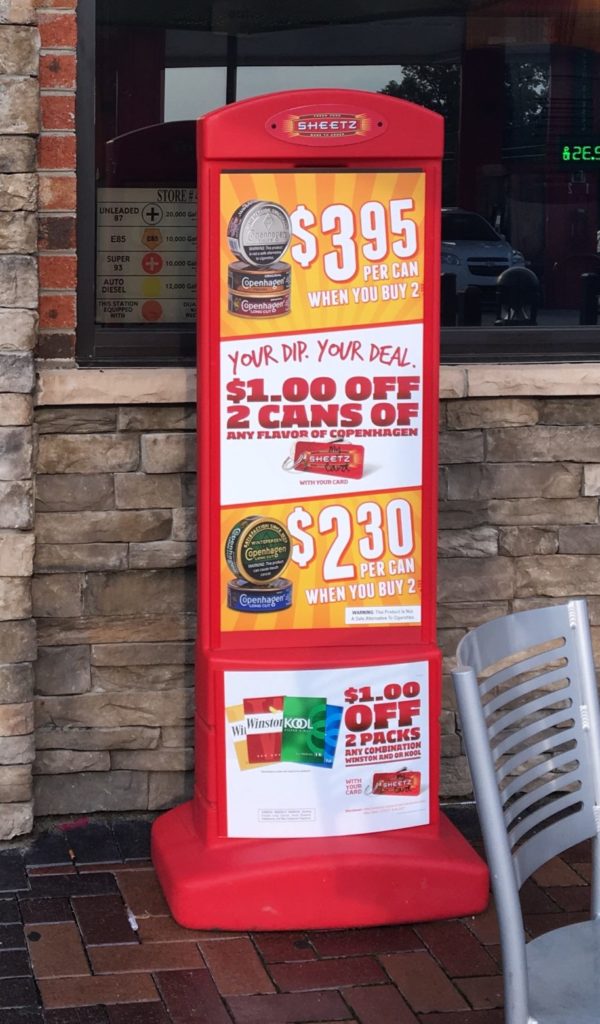A report released earlier this week from the Federal Trade Commission (FTC) on cigarette and smokeless tobacco sales and marketing expenditures show that in 2022, cigarettes sales decreased to 172.5 billion – an 8.8% drop from 2021. This marks the second time cigarette sales fell under 200 billion, following a similar drop in 2021. This decline represents enormous public health progress over the course of decades, but so much work still remains, particularly at the point of sale. The FTC data also shows the consequences of the fact that while public health policies have set limits on avenues for tobacco marketing, the retail environment remains relatively free of restrictions. The tobacco industry continues to take full advantage of that gap, spending the large majority of all of their marketing dollars there – at the point of sale.
In 2022, the tobacco industry spent over $8.3 billion marketing and promoting cigarettes and smokeless tobacco at the point of sale. These point-of-sale expenditures account for over 97% of the tobacco companies’ total marketing dollars spent on cigarettes and smokeless tobacco combined. These figures from the Federal Trade Commission Reports on Cigarettes and Smokeless Tobacco Sales and Marketing Expenditures for 2022 document a continued concentration of tobacco industry expenditures in the retail environment. The FTC has been preparing reports on sales, advertising, and promotions of cigarettes since 1967 and smokeless tobacco since 1987. Reports are issued periodically and give tobacco control advocates detailed advertising and promotion spending reports in more than two dozen categories. The spending reports show that tobacco companies spend the majority of their marketing dollars on two categories: price discounts and promotional allowances to keep products cheap and visible at the point of sale. See more details on their expenditures at the point of sale here.
Of the $8.3 billion spent at the point of sale, $6.6 billion was spent directly in the retail environment, including price discounts and promotional allowances paid to retailers, coupons, sampling, and consumer engagement, with the remainder comprised of price discounts and promotional allowances paid to wholesalers, which also ultimately reduce the price of products to consumers. Price discounts, which counteract the impact of tobacco control policies like excise taxes and target youth and other populations that are price-sensitive, comprise nearly 86% of total tobacco industry marketing expenditures on cigarettes and smokeless tobacco products. Learn more about strategies to prohibit discounting on our page on increasing tobacco prices through non-tax approaches.

- What are Price Discounts? Price discounts are what tobacco companies pay to cigarette retailers or wholesalers in order to reduce the price of cigarettes to consumers, including off-invoice discounts, buy-downs, voluntary price reductions, and trade programs.
- What are Promotional Allowances? Promotional allowances are what tobacco companies pay to either cigarettes retailers or wholesalers in order to facilitate the sale or placement of tobacco products. For retailers, this can include payments for stocking, shelving, displaying and merchandising brands, volume rebates, incentive payments, and the cost of tobacco products given to retailers for free for subsequent sale to consumers. For wholesalers, this can include payments for volume rebates, incentive payments, value added services, promotional execution and satisfaction of reporting requirements.
Other key notes in the reports for 2022:
- The was the third year that the smokeless tobacco report has included sales of nicotine pouches and lozenges that do not contain tobacco, and sales of those products totaled $1.06 billion, more than double their sales in 2020.
- Menthol cigarettes comprised 36% of the market (among the major manufacturers required to report data to the FTC). The market share of menthol cigarettes has more than doubled since 1963 when it comprised 16%. This is due to the tobacco industry’s relentless and targeted marketing of these deadly products, particularly to African Americans and other marginalized communities. Learn more about menthol.
- Menthol smokeless tobacco comprised 51.3% of sales by pound sold and 54.6% of dollar sales; fruit-flavored smokeless tobacco products comprised 2.6% of sales by pounds sold and 2.7% of dollar sales; alcohol-flavored smokeless tobacco comprised 0.06% of sales by pounds sold and 0.02% in dollar sales; and other-flavored smokeless tobacco comprised 1.9% of sales by pounds sold and 0.8% of dollar sales.
Remember that these numbers are for cigarettes and smokeless tobacco alone – they do not include any marketing expenditures for cigarillos, little cigars, e-cigarettes, or any other tobacco products. The FTC has started issuing reports on e-cigarette marketing expenditures, and it has released data from through 2020 (see our summary of that data here: FTC E-Cigarette Report Shows Importance of Flavors, Price Discounts). We will report on the updated e-cigarette data from the FTC separately when they are released, as well as report on the combined sales and marketing expenditures across products, which you can see for 2020 on our page on the War in the Store.
Tobacco marketing at the point of sale matters. Research shows that tobacco marketing can cause youth to start smoking, keep current smokers hooked, and make it harder for current and former users to quit and stay quit. These FTC reports emphasize the critical need to monitor and address tobacco industry activity in the retail environment. Learn more about the FTC reports, The War in the Store, and strategies to limit price discounts, promotions, and point-of-sale advertising in your community.
Read the reports:
- Federal Trade Commission Smokeless Tobacco Report for 2022
- Federal Trade Commission Cigarette Report for 2022


